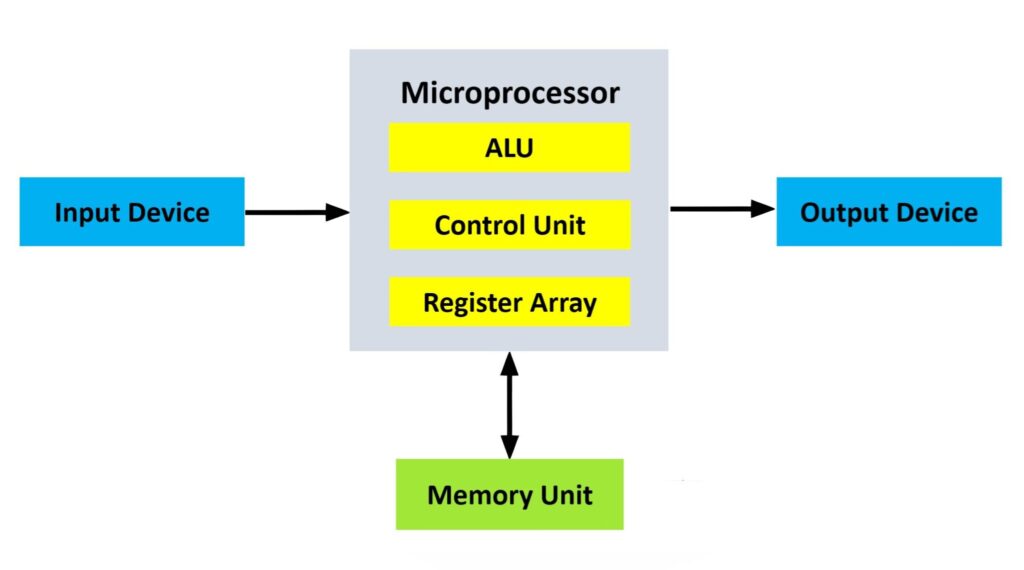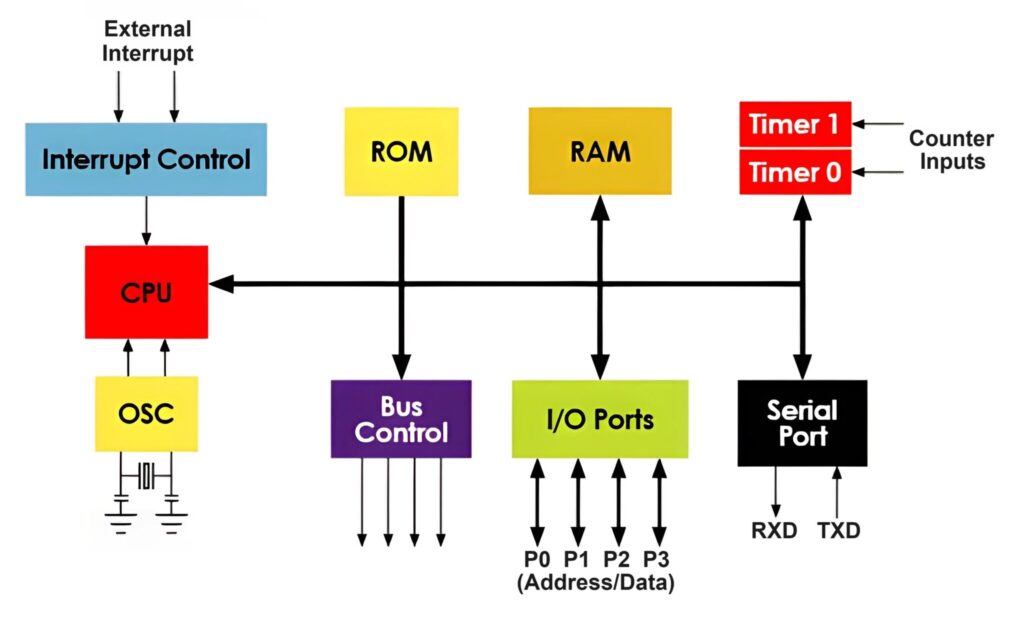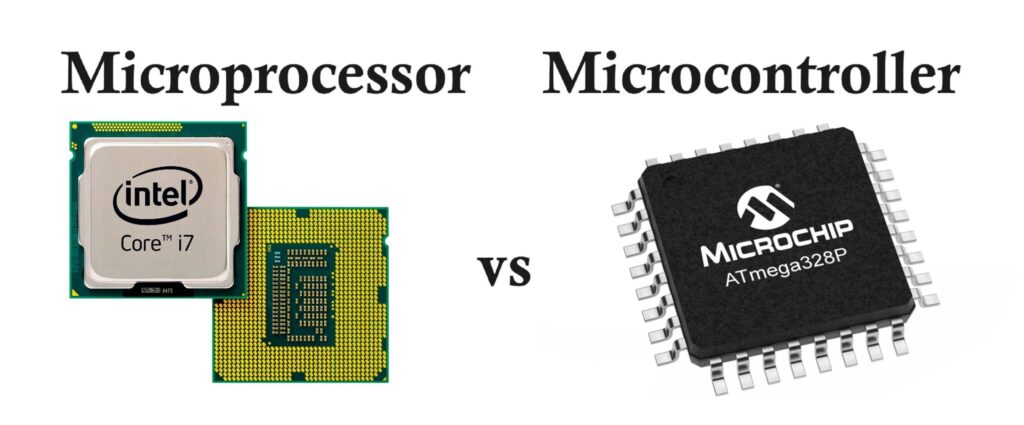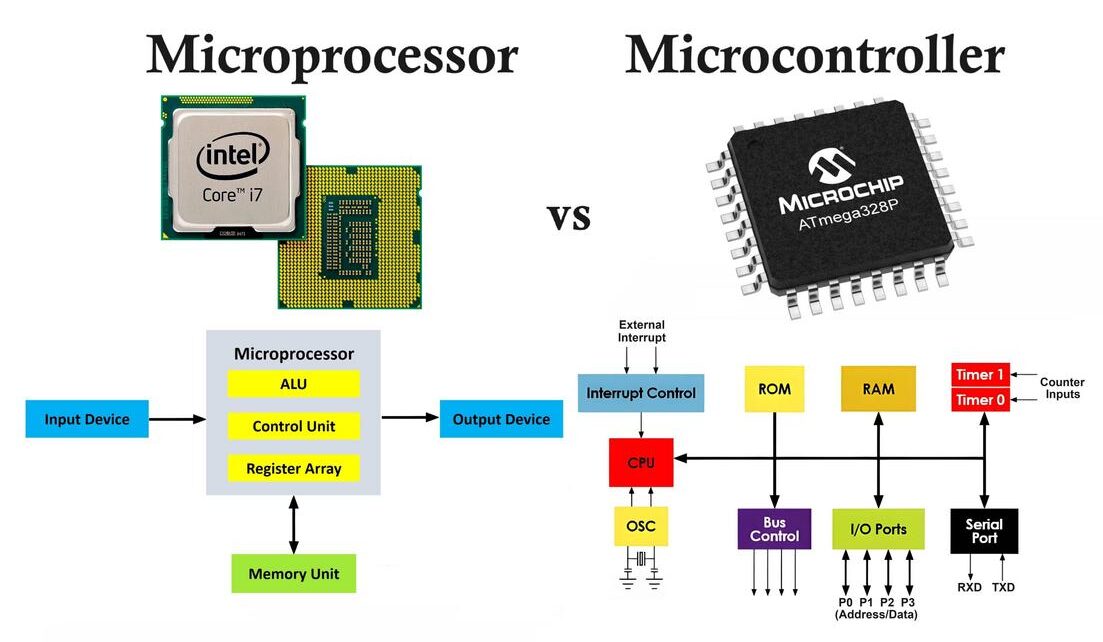Let’s understand in detail what are the difference between Microprocessor and Microcontroller. Microprocessors and microcontrollers are both essential components in the field of electronics and computing, but they serve different purposes and have distinct architectures and applications. Here are the key differences between them:
What is Microprocessor?
A microprocessor is a central processing unit (CPU) on a single integrated circuit (IC) that performs the arithmetic, logic, control, and input/output (I/O) operations specified by a program’s instructions. It is the brain of a computer or any computing device, responsible for executing a sequence of stored instructions to perform tasks and operations.
History and Evolution:
The microprocessor revolution began in the early 1970s with the introduction of the Intel 4004, the first commercially available microprocessor.
Intel 8086 was introduced in 1978, a 16-bit microprocessor that became the foundation of x86 architecture. This architecture is still prevalent in most personal computers today.
Since then, microprocessors have evolved significantly, increasing in complexity, speed, and functionality. Modern microprocessors feature multiple cores, advanced instruction sets, and integrated graphics processing units (GPUs), among other enhancements.
Importance:
Microprocessors are crucial in modern computing as they:
- Enable the execution of complex algorithms and processing tasks.
- Form the backbone of personal computing devices.
- Drive advancements in technology, including artificial intelligence, data analysis, and internet of things (IoT) devices.
Key Characteristics of Microprocessor:
Components:
Arithmetic Logic Unit (ALU): Performs arithmetic and logic operations.
Control Unit (CU): Directs the operation of the processor by telling the memory, ALU, and I/O devices how to respond to the instructions that have been sent to the processor.
Registers: Small, fast storage locations within the CPU used to hold data temporarily.

Function:
Executes instructions from a program, performing basic arithmetic, logic, control, and I/O operations required by the software.
External Components:
Requires external memory (RAM, ROM) and peripherals (I/O ports, timers) to form a complete computing system.
Processing Power:
Typically offers high processing power and speed, capable of handling complex and intensive computational tasks.
Common Microprocessors:
- Intel x86 Series: Intel Core i3, i5, i7, and i9 processors.
- AMD Ryzen Series: Ryzen 3, 5, 7, and 9 processors.
- ARM Processors: Commonly used in mobile devices and embedded systems, such as the Cortex series.
Applications of Microprocessors:
Microprocessors are versatile and powerful, making them suitable for a wide range of applications.
Personal Computers (PCs):
- Power the central processing unit (CPU) in desktops and laptops.
- Handle complex computations, multitasking, and running software applications.
Servers:
- Used in data centers and enterprise environments.
- Manage large-scale data processing, hosting websites, and cloud services.
Gaming Consoles:
Provide the computational power for rendering graphics and processing game logic.
Smartphones and Tablets:
- Serve as the main processor in mobile devices.
- Enable functionalities such as running apps, handling multimedia, and managing connectivity.
Embedded Systems in Automobiles:
Control advanced features like infotainment systems, navigation, and driver-assistance systems (ADAS).
Industrial Automation:
- Used in programmable logic controllers (PLCs) and industrial PCs.
- Manage manufacturing processes, robotics, and automation tasks.
Medical Devices:
- Power diagnostic equipment like MRI machines and CT scanners.
- Process complex medical data and assist in patient monitoring systems.
Consumer Electronics:
- Found in devices like smart TVs, digital cameras, and home automation systems.
- Enable processing of multimedia content, user interfaces, and connectivity features.
Networking Equipment:
- Used in routers, switches, and network servers.
- Handle data routing, network management, and security functions.
Aerospace and Defense:
- Provide computational power for avionics, satellite systems, and defense applications.
- Manage navigation, communication, and real-time data processing.
What is Microcontroller?
A microcontroller is a compact integrated circuit designed to perform specific control functions in embedded systems. It combines a processor core (CPU) with memory and peripheral interfaces, all within a single chip. This integration allows microcontrollers to manage various tasks efficiently, making them ideal for a wide range of applications.
History and Evolution:
The 1974 Texas Instruments TMS1000 is considered as first true microcontroller, with a processor, RAM, ROM, and I/O on one chip. In late 1970s companies like Intel 8048 and Motorola 6801 developed microcontrollers, leading to their use in appliances, automotive, and industrial applications. Widespread use of 8-bit microcontrollers like the Intel 8051 and Microchip’s PIC series started in 1980s. Features like ADC, communication, and other IOT features where added in later years.
Key Components of Microcontroller:
CPU (Central Processing Unit):
The brain of the microcontroller that performs arithmetic and logic operations, controls data flow, and executes instructions from the program.
Memory:
RAM (Random Access Memory): Temporary storage for data and variables used during program execution.
ROM (Read-Only Memory) or Flash Memory: Permanent storage for the program code. Flash memory can be erased and reprogrammed, making it versatile for different applications.

I/O Ports (Input/Output Ports):
Interfaces for connecting the microcontroller to other devices like sensors, displays, keyboards, and other peripherals. They enable communication with the external environment.
Timers/Counters:
Modules that help in generating precise time delays, measuring time intervals, or counting events.
ADC (Analog to Digital Converter):
Converts analog signals from sensors into digital data that the microcontroller can process.
DAC (Digital to Analog Converter) (if available):
Converts digital signals back into analog form.
Communication Interfaces:
Modules like UART (Universal Asynchronous Receiver/Transmitter), SPI (Serial Peripheral Interface), I2C (Inter-Integrated Circuit), and others for serial communication with other devices.
Interrupt Control:
Mechanism to handle asynchronous events, allowing the microcontroller to respond to external or internal events immediately, improving real-time performance.
Popular Microcontroller Families:
Arduino:
Based on various microcontroller families like ATmega (e.g., ATmega328 in Arduino Uno) and ARM Cortex.
PIC Microcontrollers:
Produced by Microchip Technology, known for their wide range of applications and ease of use.
AVR Microcontrollers:
Developed by Atmel (now part of Microchip Technology), used in many DIY and hobbyist projects.
ARM Cortex-M:
A popular series of microcontrollers based on ARM architecture, known for their performance and low power consumption, used in both consumer and industrial applications.
Applications of Microcontrollers:
Microcontrollers are widely used in various applications due to their versatility, cost-effectiveness, and efficiency in handling specific tasks. Some common applications include:
Consumer Electronics:
Devices like microwaves, washing machines, and remote controls.
Automotive:
Engine control units, anti-lock braking systems (ABS), and infotainment systems.
Home Automation:
Smart thermostats, lighting controls, and security systems.
Industrial Automation:
Control systems for machinery, robotics, and process control.
Medical Devices:
Portable health monitors, infusion pumps, and diagnostic equipment.
IoT (Internet of Things):
Smart home devices, wearable technology, and environmental monitoring systems.
Difference Between Microprocessor and Microcontroller:
key differences between a microprocessor and a microcontroller:

| Feature | Microprocessors | Microcontrollers |
|---|---|---|
| Definition | A central processing unit (CPU) on a single integrated circuit (IC) designed to perform computations and manage data. | A compact integrated circuit designed to perform specific control functions, combining a processor, memory, and peripherals. |
| Architecture | Microprocessors are based on the von Neumann architecture, programs and data are stored in the same memory module | Microcontrollers are based on Harvard architecture, here program memory and Data memory are separate |
| Number of Registers | Microprocessors have a smaller number of registers, here more operations are memory based | Microcontrollers have more registers and programs are easier to write |
| Components | Contains only the CPU; other components like RAM, ROM, and I/O ports are external. | Contains CPU, RAM, ROM, I/O ports, timers, and sometimes other peripherals all on a single chip. |
| Primary Application | Used in general-purpose computing tasks, such as in PCs, laptops, and servers. | Used in embedded systems for specific control tasks, such as in appliances, automobiles, and industrial machines. |
| Memory | Requires external memory to function (both RAM and ROM). | Has built-in memory (both RAM and ROM) on the chip itself. |
| I/O Ports | Requires external interfacing for I/O ports. | Built-in I/O ports for direct interfacing with external devices. |
| Complexity | More complex in terms of the number of components and connections needed. | Less complex due to integration of components on a single chip. |
| Power Consumption | Generally higher power consumption due to separate components and higher processing power. | Typically lower power consumption due to integrated components and designed for efficiency. |
| Cost | Usually more expensive overall when considering the need for external components. | Generally cheaper as it integrates many functions on a single chip. |
| Processing Power | Higher processing power suitable for complex and general-purpose tasks. | Lower processing power, optimized for specific tasks and control operations. |
| Flexibility | More flexible for a wide range of applications due to separate components. | Less flexible but highly optimized for specific control applications. |
| Development and Prototyping | Typically more complex and costly, requiring more components and tools. | Easier and more cost-effective due to the integration of necessary components on one chip. |
| Example | Intel Core i7, AMD Ryzen | Arduino (ATmega328), PIC16F877A |
These differences between microprocessor and microcontroller highlights their distinct roles and application in various computing and control systems.
Microprocessor and Microcontroller Summary:
A microprocessor is a versatile and powerful component that acts as the central unit of computation in various digital devices. Its ability to process a vast array of instructions rapidly makes it an indispensable part of contemporary technology, powering everything from simple embedded systems to sophisticated computing environments.
A microcontroller is a versatile and compact integrated circuit that combines a CPU, memory, and peripheral interfaces to perform specific control tasks. Its integration and efficiency make it an essential component in various embedded systems, spanning consumer electronics, automotive, industrial, medical, and IoT applications.
Raspberry Pi 5 Pinout, specifications, Pricing A Complete Guide
